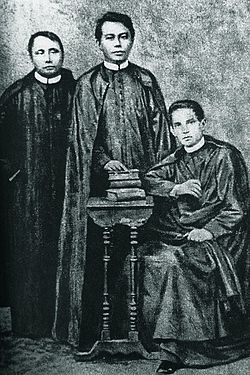Gomburza: Difference between revisions
| Line 9: | Line 9: | ||
Father Burgos was a ''criollo'', a [[Doctor of Philosophy]]{{Fact|date=July 2007}} whose prominence extended even to Spain, such that when the new Governor and Captain-General [[Carlos María de la Torre (Spaniard)|Carlos María de la Torre]] arrived from Spain to assume his duties, he invited Burgos to sit beside him in his carriage during the inaugural procession, a place traditionally reserved for the [[Archbishop]] and who was a peninsular Spaniard. The arrival of the liberal governor De la Torre was opposed by the ruling minority of friars, regular priests who belonged to an order ([[Dominican Order|Dominicans]], [[Augustinians]], [[Recollects]] and [[Franciscans]]) and their allies in civil government, but supported by the secular priests, most of whom were ''mestizos'' and ''indios'' assigned to [[parish]]es and far-flung communities, who believed that the reforms and the equality they wanted with peninsular Spaniards coming. In less than two years, De la Torre was replaced by [[Rafael de Izquierdo]]. |
Father Burgos was a ''criollo'', a [[Doctor of Philosophy]]{{Fact|date=July 2007}} whose prominence extended even to Spain, such that when the new Governor and Captain-General [[Carlos María de la Torre (Spaniard)|Carlos María de la Torre]] arrived from Spain to assume his duties, he invited Burgos to sit beside him in his carriage during the inaugural procession, a place traditionally reserved for the [[Archbishop]] and who was a peninsular Spaniard. The arrival of the liberal governor De la Torre was opposed by the ruling minority of friars, regular priests who belonged to an order ([[Dominican Order|Dominicans]], [[Augustinians]], [[Recollects]] and [[Franciscans]]) and their allies in civil government, but supported by the secular priests, most of whom were ''mestizos'' and ''indios'' assigned to [[parish]]es and far-flung communities, who believed that the reforms and the equality they wanted with peninsular Spaniards coming. In less than two years, De la Torre was replaced by [[Rafael de Izquierdo]]. |
||
Ahhh... putang |
Ahhh... putang inang yan. Ahhh...? |
||
==The Cavite Mutiny== |
==The Cavite Mutiny== |
||
Revision as of 19:16, 26 September 2011


Gomburza or GOMBURZA is an acronym denoting the surnames of the priests Mariano Gómez, José Apolonio Burgos, and Jacinto Zamora, three Filipino priests who were executed on 17 February 1872 at Bagumbayan in Manila, Philippines by Spanish colonial authorities on charges of subversion arising from the 1872 Cavite mutiny. Their execution left a profound effect on many Filipinos; José Rizal, the national hero, would dedicate his novel El filibusterismo to their memory.[1]
The uprising by workers in the Cavite Naval Yard was the pretext[2][3] needed by the authorities to redress a perceived humiliation from the principal objective, José Burgos, who threatened the established order.
Background
During the Spanish colonial period, four social class distinctions were observed in the islands. These were 1) Spaniards who were born in Spain— peninsulares, 2) Spaniards born in the colonies of Spain (Latin America or the Philippines)—insulares or criollos, 3) Spanish mestizos, Chinese mestizos or 'Indios' (natives) dwelling within or near the city (or town) and the church, and, finally, 4) Chinese or Sangley and rural Indios.[4]
Father Burgos was a criollo, a Doctor of Philosophy[citation needed] whose prominence extended even to Spain, such that when the new Governor and Captain-General Carlos María de la Torre arrived from Spain to assume his duties, he invited Burgos to sit beside him in his carriage during the inaugural procession, a place traditionally reserved for the Archbishop and who was a peninsular Spaniard. The arrival of the liberal governor De la Torre was opposed by the ruling minority of friars, regular priests who belonged to an order (Dominicans, Augustinians, Recollects and Franciscans) and their allies in civil government, but supported by the secular priests, most of whom were mestizos and indios assigned to parishes and far-flung communities, who believed that the reforms and the equality they wanted with peninsular Spaniards coming. In less than two years, De la Torre was replaced by Rafael de Izquierdo. Ahhh... putang inang yan. Ahhh...?
The Cavite Mutiny
The so-called Cavite Mutiny of workers in the arsenal of the naval shipyard over pay reduction owing to increased taxation produced a willing witness to implicate the three priests, who were summarily tried and sentenced to death by garrote on February 17, 1872. The bodies of the three priests were buried in a common, unmarked grave in the Paco Cemetery, in keeping with the practice of burying enemies of the state.[2] Significantly, in the archives of Spain, there is no record of how Izquierdo, himself a liberal, could have been influenced to authorize these executions.[citation needed] Gregorio Meliton Martinez, then the Archbishop of Manila, refused to defrock the priests, citing they did not break any canon law. He ordered the bells of every church to be rung in honor of the executed priests. The aftermath of the investigation produced scores of suspects, most of whom were exiled to Guam in the Marianas. Except for a few who managed to escape to other ports like Hong Kong, most of the suspects died there.
Recovery of remains
Early in 1998, bones believed to belong to one of the three executed priests were discovered at the Paco Park Cemetery by the Manila City Engineers Office.[5]
Further reading
- Zaide, Gregorio F. (1984). Philippine History and Government. National Bookstore Printing Press.
Footnotes
- ^ "Nationalista Party History". Archived from the original on 2007-06-27. Retrieved 2007-07-30.
- ^ a b "The Secularization Issue and the Execution of Gomburza". Archived from the original on 2007-09-28. Retrieved 2007-07-30.
- ^ "Padre Jose Ma. Burgos". Retrieved 2007-07-30.
- ^ "Hidalgo and Luna: Vexed Modernity". Retrieved 2007-07-30.
- ^ Casipit, Jennifer R. "GOMBURZA. Reluctant martyrs started it all". Retrieved 2007-07-30.
